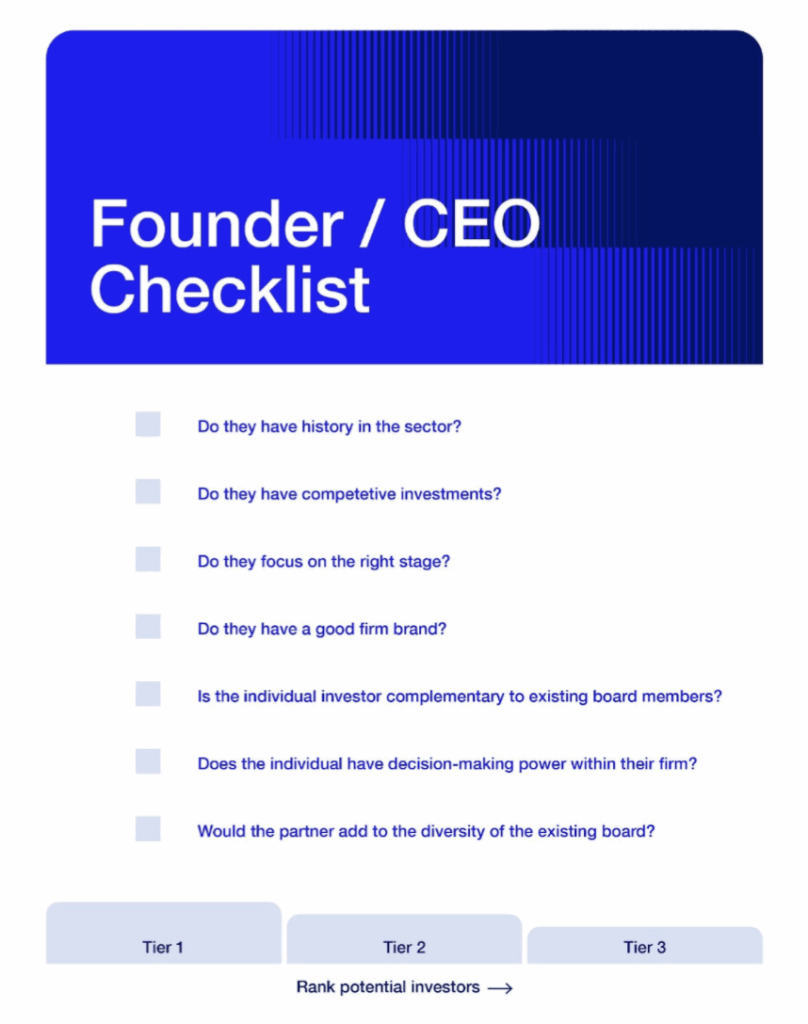

Knowing which investors to talk to and how to label your financing round can be confusing, but don’t let the murkiness slow you down! Dive into Crunchbase and/or Pitchbook and start doing your research. We recommend taking the following steps:
Why? Because you want an investment partner who already has deep knowledge of the market space you are going after. This help them be more helpful as a sounding board, recruiter, and strategic thought partner as you build your company. For simplicity, the broad categories are:
3. Make note of the firm’s typical investment size and compare that to what you believe your company needs. We recommend aiming for an amount that enables the company to execute for 24 months before needing additional capital.
Raising too much capital translates to unnecessary dilution and often, sloppy execution. Optimal innovation tends to come from constraints.
At the same time, raising too little capital puts you at risk of falling short of the threshold goals and valuation inflection, and that’s the worst possible outcome. If you have goals that will take longer than 24 months to achieve, break them down into more manageable increments.
“History teaches us that optimal innovation comes from constraints. At the same time, raising too little capital puts you at risk of falling short of the threshold goals and valuation inflection, and that’s the worst possible outcome.” — John Vrionis, co-founder of Unusual Ventures
4. Look at your competitors’ investors. Many investors will invest in competitive companies. But as a founder that’s something you want to avoid so there are no conflicts of interest.
5. Narrow down your list to the firms you believe will help you most with attaining your goals in the specific phase you are in.
6. Break down your list down into three tiers: Tier 1, Tier 2, and Tier 3:
If you have questions about which firms and partners belong in which tier, find trusted, experienced people to ask!
Spend the time to do your homework—you owe it to yourself and your team to be informed. That said, recognize that this is not meant to be a precise exercise. There is no 100% accurate way of doing this, so don’t stress. Now that you have your segmented list, let’s move on to the next step.

Before diving into what will inevitably be a few weeks of mania, it is important to understand three essential facts about the pitch process itself:
1. Practice makes perfect.
You will get better with each investor pitch, so make sure you warm up with two to three meetings with investors from your Tier 2 list. Think of this as testing your pitch “Off Broadway.” Then, schedule four to five Tier 1 meetings within a time-boxed two-week time frame.
2. Limit the number of firms you engage with: 5–7 at any given time.
Only add new firms if existing ones drop out or don’t engage. We recommend only speak to investors who are capable of leading the investment, as they will work with you to set critical terms. Other investors may be interested in participating, but finding the lead investor comes first and deserves 100% of your initial focus.
3. Find a way to make warm introductions.
Reason being, pragmatic, good investors receive a ton of inbound emails and can only invest in a small fraction of the opportunities they receive. A warm introduction from a strong connection will help grab their attention. It also offers you the added benefit of a feedback channel post-meeting.
Once you’ve secured warm introductions to the investors on your list, the next step is to put together a top-notch pitch deck and tell your story in a way that highlights what the best investors are looking for.
A great pitch isn’t about the slides — it’s about the story and how you tell it.
At the earliest stages, investors are mostly betting on you. The way you explain your vision, your conviction, and the insight behind your company often matters more than the numbers. When you pitch, investors aren’t just evaluating your market or your deck — they’re assessing your ability to communicate and inspire.
How well you tell your story now is a leading indicator of how well you will recruit early customers, attract top employees, and raise the next round. Great VCs know this. They’re asking themselves: Would I follow this founder into an uncertain future?
Your pitch is that moment. Tell the story clearly, confidently, and with conviction.
In Unusual Academy, we provide every founder with a copy of Jerry Wiseman’s book Presenting to Win because it’s the best, most succinct content we’ve found for guiding fundraising founders.
The key takeaway is that nothing matters as much as your story, and there’s a formula you can follow to guarantee you put your best foot forward. Most of that is appreciating your audience — the investor — and understanding what they will focus on when making their decision.
Pro tip: Your investor presentation is not the same as your customer presentation. While both presentation decks are intended to sell, the investor presentation must include a compelling narrative about your team, the big opportunity for the company, the economics of the business, and the milestones that will be achieved on this specific financing. For more on how to put together customer presentations as a Seed stage company, see our Guide for building your first customer presentation.
Of note, the investor presentation should be practically useless without the voice-over. Investors want to work with a founder who has a clear command of the business and strategy.
Consider the slides your props — the main attraction must always be you! Part of the evaluation is showing how well you tell your story!